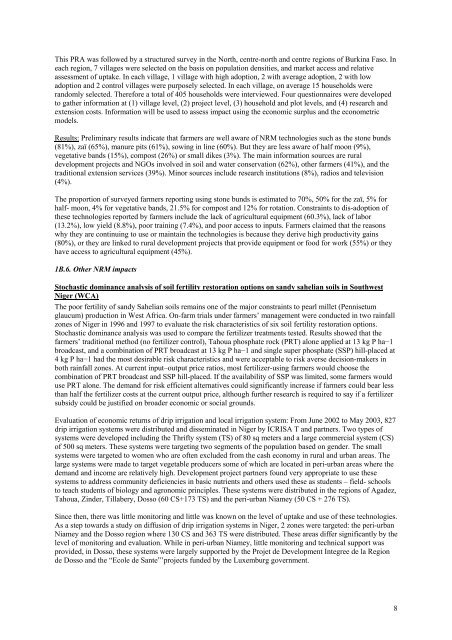ICRISAT Archival Report 2006 - The seedlings of success in the ...
ICRISAT Archival Report 2006 - The seedlings of success in the ...
ICRISAT Archival Report 2006 - The seedlings of success in the ...
Create successful ePaper yourself
Turn your PDF publications into a flip-book with our unique Google optimized e-Paper software.
This PRA was followed by a structured survey <strong>in</strong> <strong>the</strong> North, centre-north and centre regions <strong>of</strong> Burk<strong>in</strong>a Faso. In<br />
each region, 7 villages were selected on <strong>the</strong> basis on population densities, and market access and relative<br />
assessment <strong>of</strong> uptake. In each village, 1 village with high adoption, 2 with average adoption, 2 with low<br />
adoption and 2 control villages were purposely selected. In each village, on average 15 households were<br />
randomly selected. <strong>The</strong>refore a total <strong>of</strong> 405 households were <strong>in</strong>terviewed. Four questionnaires were developed<br />
to ga<strong>the</strong>r <strong>in</strong>formation at (1) village level, (2) project level, (3) household and plot levels, and (4) research and<br />
extension costs. Information will be used to assess impact us<strong>in</strong>g <strong>the</strong> economic surplus and <strong>the</strong> econometric<br />
models.<br />
Results: Prelim<strong>in</strong>ary results <strong>in</strong>dicate that farmers are well aware <strong>of</strong> NRM technologies such as <strong>the</strong> stone bunds<br />
(81%), zaï (65%), manure pits (61%), sow<strong>in</strong>g <strong>in</strong> l<strong>in</strong>e (60%). But <strong>the</strong>y are less aware <strong>of</strong> half moon (9%),<br />
vegetative bands (15%), compost (26%) or small dikes (3%). <strong>The</strong> ma<strong>in</strong> <strong>in</strong>formation sources are rural<br />
development projects and NGOs <strong>in</strong>volved <strong>in</strong> soil and water conservation (62%), o<strong>the</strong>r farmers (41%), and <strong>the</strong><br />
traditional extension services (39%). M<strong>in</strong>or sources <strong>in</strong>clude research <strong>in</strong>stitutions (8%), radios and television<br />
(4%).<br />
<strong>The</strong> proportion <strong>of</strong> surveyed farmers report<strong>in</strong>g us<strong>in</strong>g stone bunds is estimated to 70%, 50% for <strong>the</strong> zaï, 5% for<br />
half- moon, 4% for vegetative bands, 21.5% for compost and 12% for rotation. Constra<strong>in</strong>ts to dis-adoption <strong>of</strong><br />
<strong>the</strong>se technologies reported by farmers <strong>in</strong>clude <strong>the</strong> lack <strong>of</strong> agricultural equipment (60.3%), lack <strong>of</strong> labor<br />
(13.2%), low yield (8.8%), poor tra<strong>in</strong><strong>in</strong>g (7.4%), and poor access to <strong>in</strong>puts. Farmers claimed that <strong>the</strong> reasons<br />
why <strong>the</strong>y are cont<strong>in</strong>u<strong>in</strong>g to use or ma<strong>in</strong>ta<strong>in</strong> <strong>the</strong> technologies is because <strong>the</strong>y derive high productivity ga<strong>in</strong>s<br />
(80%), or <strong>the</strong>y are l<strong>in</strong>ked to rural development projects that provide equipment or food for work (55%) or <strong>the</strong>y<br />
have access to agricultural equipment (45%).<br />
1B.6. O<strong>the</strong>r NRM impacts<br />
Stochastic dom<strong>in</strong>ance analysis <strong>of</strong> soil fertility restoration options on sandy sahelian soils <strong>in</strong> Southwest<br />
Niger (WCA)<br />
<strong>The</strong> poor fertility <strong>of</strong> sandy Sahelian soils rema<strong>in</strong>s one <strong>of</strong> <strong>the</strong> major constra<strong>in</strong>ts to pearl millet (Pennisetum<br />
glaucum) production <strong>in</strong> West Africa. On-farm trials under farmers’ management were conducted <strong>in</strong> two ra<strong>in</strong>fall<br />
zones <strong>of</strong> Niger <strong>in</strong> 1996 and 1997 to evaluate <strong>the</strong> risk characteristics <strong>of</strong> six soil fertility restoration options.<br />
Stochastic dom<strong>in</strong>ance analysis was used to compare <strong>the</strong> fertilizer treatments tested. Results showed that <strong>the</strong><br />
farmers’ traditional method (no fertilizer control), Tahoua phosphate rock (PRT) alone applied at 13 kg P ha−1<br />
broadcast, and a comb<strong>in</strong>ation <strong>of</strong> PRT broadcast at 13 kg P ha−1 and s<strong>in</strong>gle super phosphate (SSP) hill-placed at<br />
4 kg P ha−1 had <strong>the</strong> most desirable risk characteristics and were acceptable to risk averse decision-makers <strong>in</strong><br />
both ra<strong>in</strong>fall zones. At current <strong>in</strong>put–output price ratios, most fertilizer-us<strong>in</strong>g farmers would choose <strong>the</strong><br />
comb<strong>in</strong>ation <strong>of</strong> PRT broadcast and SSP hill-placed. If <strong>the</strong> availability <strong>of</strong> SSP was limited, some farmers would<br />
use PRT alone. <strong>The</strong> demand for risk efficient alternatives could significantly <strong>in</strong>crease if farmers could bear less<br />
than half <strong>the</strong> fertilizer costs at <strong>the</strong> current output price, although fur<strong>the</strong>r research is required to say if a fertilizer<br />
subsidy could be justified on broader economic or social grounds.<br />
Evaluation <strong>of</strong> economic returns <strong>of</strong> drip irrigation and local irrigation system: From June 2002 to May 2003, 827<br />
drip irrigation systems were distributed and dissem<strong>in</strong>ated <strong>in</strong> Niger by ICRISA T and partners. Two types <strong>of</strong><br />
systems were developed <strong>in</strong>clud<strong>in</strong>g <strong>the</strong> Thrifty system (TS) <strong>of</strong> 80 sq meters and a large commercial system (CS)<br />
<strong>of</strong> 500 sq meters. <strong>The</strong>se systems were target<strong>in</strong>g two segments <strong>of</strong> <strong>the</strong> population based on gender. <strong>The</strong> small<br />
systems were targeted to women who are <strong>of</strong>ten excluded from <strong>the</strong> cash economy <strong>in</strong> rural and urban areas. <strong>The</strong><br />
large systems were made to target vegetable producers some <strong>of</strong> which are located <strong>in</strong> peri-urban areas where <strong>the</strong><br />
demand and <strong>in</strong>come are relatively high. Development project partners found very appropriate to use <strong>the</strong>se<br />
systems to address community deficiencies <strong>in</strong> basic nutrients and o<strong>the</strong>rs used <strong>the</strong>se as students – field- schools<br />
to teach students <strong>of</strong> biology and agronomic pr<strong>in</strong>ciples. <strong>The</strong>se systems were distributed <strong>in</strong> <strong>the</strong> regions <strong>of</strong> Agadez,<br />
Tahoua, Z<strong>in</strong>der, Tillabery, Dosso (60 CS+173 TS) and <strong>the</strong> peri-urban Niamey (50 CS + 276 TS).<br />
S<strong>in</strong>ce <strong>the</strong>n, <strong>the</strong>re was little monitor<strong>in</strong>g and little was known on <strong>the</strong> level <strong>of</strong> uptake and use <strong>of</strong> <strong>the</strong>se technologies.<br />
As a step towards a study on diffusion <strong>of</strong> drip irrigation systems <strong>in</strong> Niger, 2 zones were targeted: <strong>the</strong> peri-urban<br />
Niamey and <strong>the</strong> Dosso region where 130 CS and 363 TS were distributed. <strong>The</strong>se areas differ significantly by <strong>the</strong><br />
level <strong>of</strong> monitor<strong>in</strong>g and evaluation. While <strong>in</strong> peri-urban Niamey, little monitor<strong>in</strong>g and technical support was<br />
provided, <strong>in</strong> Dosso, <strong>the</strong>se systems were largely supported by <strong>the</strong> Projet de Development Integree de la Region<br />
de Dosso and <strong>the</strong> “Ecole de Sante”’projects funded by <strong>the</strong> Luxemburg government.<br />
8

















